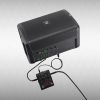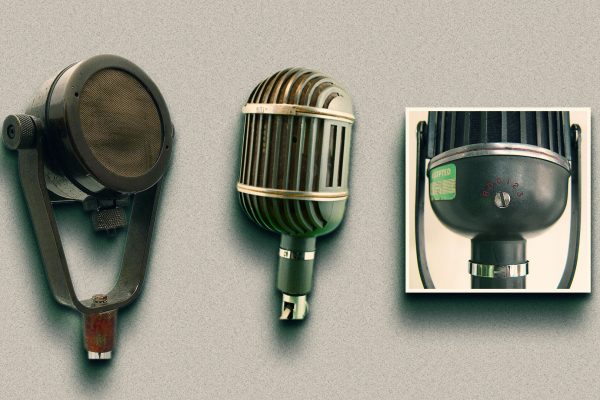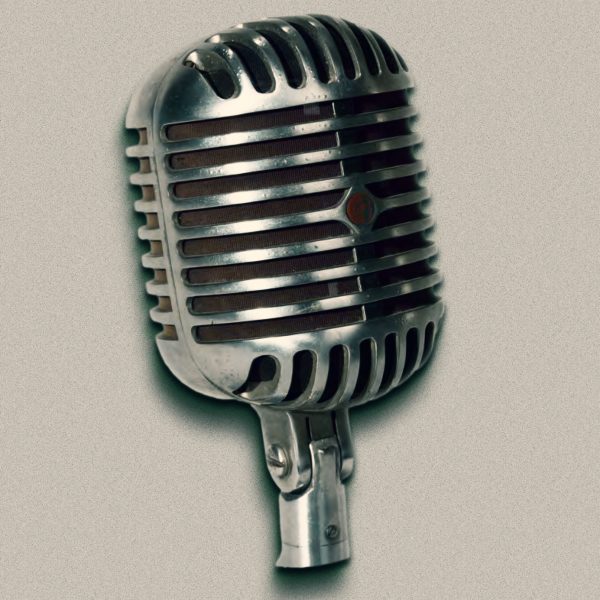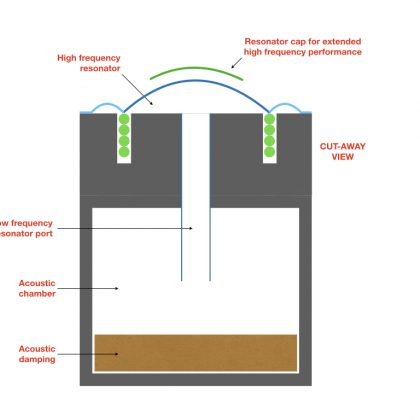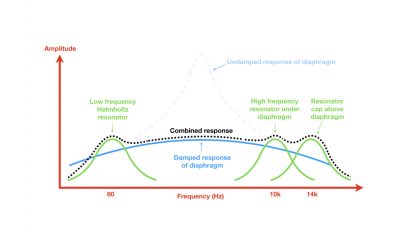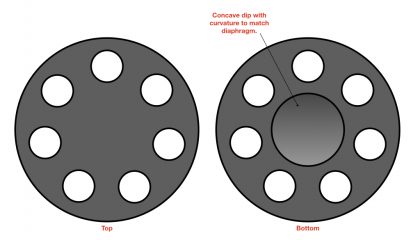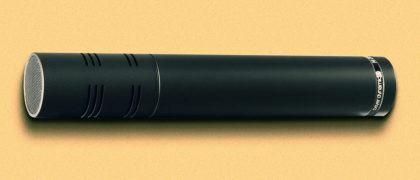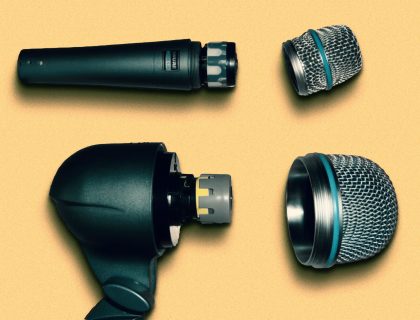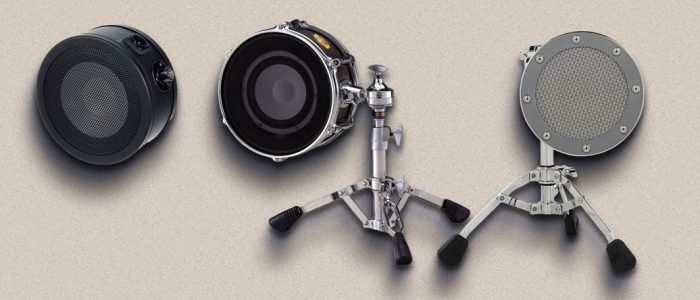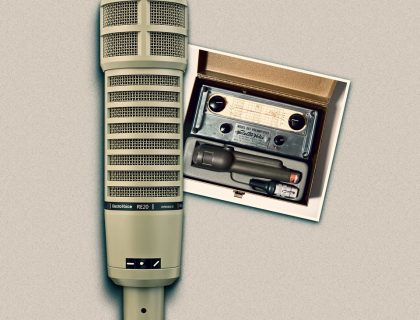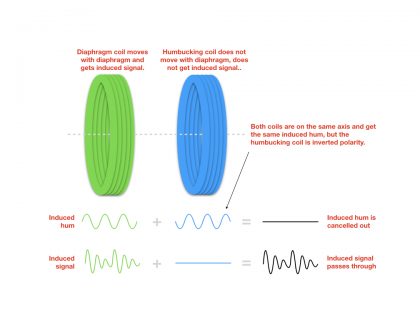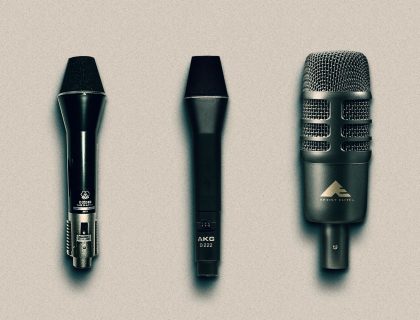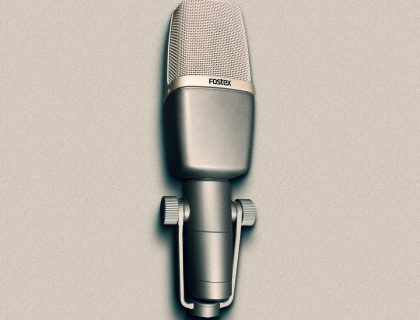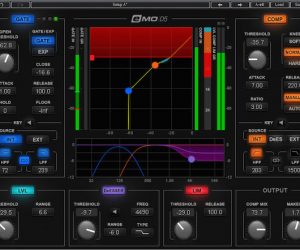
Dynamic Microphones
In the third instalment of this series, Greg Simmons delves deep into dynamic mics to find out what makes them sound like they do, when to use them and when to avoid them.
In the first instalment of this series we saw that in the typical ‘capture’ path – from microphone to preamp to converter – the microphone was responsible for about 85% of the tonality of the captured sound. In the second instalment we looked at how ribbon microphones work, why they sound the way they do, and how they’ve benefitted from technological advances.
In this instalment we’ll be looking at dynamic microphones: how they work, the factors that influence their characteristic tonality, and how their design has benefitted from advances in technology. In the next instalment we’ll do the same for condenser microphones.
CAPSULE
Before going any further it’s important to define the term capsule, which is often mentioned when talking about dynamic and condenser microphones. The term capsule generally refers to the diaphragm and associated components required for the basic transducer role of converting sounds into signals. It is used to differentiate these parts of the microphone from the microphone’s body, which often houses additional electronic and acoustic components to improve the performance of the capsule, as we’re about to see…
DYNAMIC MICROPHONES
Although invented in 1897 by Ernst Siemens, the dynamic microphone we’re familiar with today can be traced back to a 1931 improvement on Siemens’ design by Edward Wente and Albert Thuras. The first commercially available dynamic mic was the Western Electric (aka Altec) Model 618A, which entered production in 1931. An omnidirectional, it was soon followed by the 639A and 639B which both contained an omnidirectional dynamic capsule along with a bidirectional ribbon element. Internally combining the bidirectional ribbon with the omnidirectional dynamic allowed different polar responses to be created. (This concept remains fundamental to how microphones with electronically switchable polar responses work, and is explained in a later instalment of this series).
The 639A offered three polar responses: ‘R’ selected the ribbon element and was therefore bidirectional, ‘D’ selected the dynamic capsule and was therefore ‘non-directional (omnidirectional), and ‘C’ selected the combined ribbon (bidirectional) and dynamic (omnidirectional) to create a cardioid response. The 639B added what appear to be hypercardioid, supercardioid, and a slight variation of the standard cardioid with a tiny rear lobe – all created through different combinations of the bidirectional ribbon and omnidirectional dynamic. It’s worth noting that although the 639B’s marketing documentation uses the term ‘cardioid’, these three new responses are simply numbered ‘1’, ‘2’ and ‘3’ and are described as being “special cardioid patterns each with two dead zones” (nulls). Similarly, RCA’s 77D and 77DX ribbon microphones (released about five years after the 639A and 639B) offered six polar responses labelled ‘U’ for ‘Unidirectional’ (cardioid), ‘N’ for ‘non-directional’ (omnidirectional), ‘B’ for ‘Bidirectional’, and three other responses simply called ‘L1’, ‘L2’ and ‘L3’ representing variations between cardioid and bidirectional. Obviously, the mathematical definitions and terminology for ‘hypercardioid’ and ‘supercardioid’ came later…
In 1939 Shure released the Unidyne 55, the first dynamic microphone to offer a cardioid response using only a single diaphragm/capsule – a development by Shure’s Ben Bauer. His design used ports at the rear of the microphone to achieve cancellation of sounds arriving from the rear, creating what Shure called the ‘uniphase’ principle. Bauer’s development changed the world of microphone design and is now used in almost every single-diaphragm microphone that offers a cardioid, supercardioid, hypercardioid or subcardioid polar response. (Harry F. Olson used a variation of Bauer’s design in RCA’s 77D and 77DX ribbon microphones, replacing the complex acoustic labyrinths used in the earlier 77A, 77B, 77C, and KU2 with a simpler system of rear ports that could be opened or sealed by rotating a cam-shaped baffle.)
Many iconic ‘industry standard’ microphones have been released since the Unidyne 55, all using or building upon Bauer’s design. These include AKG’s D12 (1953), Sennheiser’s MD421 (1960), BeyerDynamic’s M88 (1962), Shure’s SM57 (1965) and SM58 (1966), Electro-Voice’s RE20 (1968) and Sennheiser’s MD441 (1971). Great advancements took place in dynamic microphone design throughout the 1960s, contributing to the decline in popularity of ribbon microphones as mentioned in the previous instalment.
In 2014 Shure received an IEEE Milestone award in recognition of Bauer’s development for the Unidyne 55 and its significance in the history of microphone design.
DYNAMIC TRANSDUCTION
Like the ribbon microphones described in the previous instalment, dynamic microphones use magnetic induction to convert a sound into a signal. Instead of using a corrugated ribbon of aluminium, however, a coil of wire is attached to the back of a diaphragm (a circular membrane suspended in the air). The diaphragm is dome-shaped which, among other things, provides the structural integrity needed to support the coil. As with a ribbon element, the coil is immersed in a magnetic field. Sound vibrations cause the diaphragm to vibrate, moving the coil within the magnetic field and inducing an electrical current into it. For this reason, dynamic microphones are sometimes referred to as moving coil microphones. Every winding in the coil has a current induced into it, which collectively adds up to a higher induced current than could be created with a ribbon element in the same magnetic field (a ribbon is essentially just one winding of a coil).
Theoretically, the dynamic microphone doesn’t need a transformer because the diaphragm’s coil is fundamentally the same as the output of a transformer and can be connected directly to an XLR socket to provide a balanced differential output. However, many dynamic microphones rely on a transformer nonetheless for similar reasons as the ribbon microphone: to increase the signal level, provide a more appropriate output impedance, and provide a balanced differential output that’s suitable for driving the signal down a microphone cable and into a preamp. Electro-Voice’s RE20 and Shure’s SM58 both use transformers, while Electro-Voice’s RE320 and Shure’s Beta 58 do not. (Interestingly, Shure went back to using a transformer in the Beta 58A.)
One popular modification for Shure’s SM57 is to remove the transformer, which reportedly smooths out the frequency response and improves the high frequencies – at the expense of losing the 10dB of voltage gain provided by the transformer. There is plenty of ‘how to’ information online for this mod, and also for replacing the transformer with alternative versions, but be aware that these mods will void the microphone’s warranty and also change its characteristic tonality – which was probably what you bought it for in the first place. An in-line booster (see below) might be a better option…
FACTORS AFFECTING TONALITY
Although the dynamic microphone uses the same principle of magnetic induction as the ribbon microphone, its considerably heavier coil/diaphragm assembly results in reduced sensitivity to high frequencies and slower response to transients. Unlike the gentle high frequency roll-off of ribbon microphones or the extended high frequency response of condenser microphones, dynamic microphones roll-off rapidly – rarely reaching 20kHz at any notable level.
RESONATORS & DAMPERS
The dynamic microphone has a number of significant resonances; in fact, its entire frequency response could be considered as a series of controlled resonances. The first is the resonance of the diaphragm itself, which is often illustrated as being centred somewhere around 800Hz, depending on the mass, diameter and suspension. This resonance creates a large peak in the frequency response that resembles an inverted ‘V’, and is far from the straight horizontal line that’s considered ideal. Acoustic damping is applied to reduce this peak considerably. Although it is possible to damp the diaphragm’s resonance down to a flat response, increasing the damping decreases the diaphragm’s sensitivity and results in lower output so it’s always a compromise.
Other resonating systems and dampers are added as a form of passive EQ to extend the overall frequency response. One of these is a narrow tube that connects the air chamber behind the diaphragm to a larger acoustic chamber inside the mic body, forming a Helmholtz resonator (similar to a ported speaker enclosure) that boosts the low frequencies and balances them against the diaphragm’s damped resonant peak. Likewise, a resonating cavity is built into the dome-shaped space inside the diaphragm to boost the high frequencies and balance them against the low and midrange frequencies. The result of these three resonating systems – the diaphragm, the Helmholtz resonator and the resonating cavity behind the diaphragm – provides reasonably good bandwidth.
Additional resonators and dampers may be added to further enhance the performance and/or give the microphone its characteristic tonality. For example, beneath the wire mesh and internal foam wind filter of Shure’s SM57 is a small plastic disc with holes around the perimeter. It sits immediately above the diaphragm, assumedly to protect it from the foam. The underside of this disc, however, has a concave dip in the centre with a curvature that follows the top of the diaphragm; this creates a small resonating chamber immediately above the diaphragm that’s tuned to extend the high frequency performance. This is known as a resonator cap and is commonly used in dynamic microphones – look for a small dome of some kind sitting immediately above the diaphragm.
The result of these controlled resonances working together is a far better frequency response than the diaphragm alone can provide. Although the quoted frequency response for a typical dynamic microphone extends higher than that of a typical ribbon microphone, once the dynamic microphone reaches its quoted upper limit the high frequency roll-off is usually steeper. Fortunately, dynamic microphone designers are usually able to place the high frequency roll-off somewhere above 12kHz, which is high enough to avoid terms like ‘dull’ and ‘muffled’ – descriptions that would certainly be used if the same steep roll-off occurred just a bit lower.
The inside of a dynamic microphone is a work of miniature acoustic engineering art. A look inside Sennheiser’s 421 quickly explains its size and shape, with a bass pre-emphasis pipe from the back of the capsule feeding into a large acoustic chamber shaped to form a broadband resonator, along with four rear vents/ports, a resonator cap and numerous damping systems. There’s also a humbucking coil, a transformer and a five-position bass roll-off control. Even Shure’s visually simple SM57 contains numerous resonating cavities and damping materials, including the cavity inside the handle itself – as Granelli Audio Labs discovered while prototyping their G5790 (a modified Shure SM57 with a right-angle bend to make it easier for close-miking drums). They had to re-work their initial design to make sure it didn’t alter the original tonality of the SM57 – otherwise they wouldn’t be able to market it as “The mic you’ve always loved, the mod you’ve always needed.”
In 1939 Shure released the Unidyne 55, the first dynamic microphone to offer a cardioid response using only a single diaphragm/capsule...
DIAPHRAGM PARAMETERS
Diaphragm diameter also plays a role in the tonality of a dynamic microphone, especially when considered with the size/weight of the coil. A larger diaphragm can support a larger coil which potentially means a higher induced current, but with reduced high frequency sensitivity due to the increased weight. The smaller and lighter the diaphragm/coil assembly is, the faster it can move – resulting in better high frequency performance and transient response. BeyerDynamic’s M201 is a relatively small dynamic microphone (outer dimensions measure 160mm x 24mm), presumably containing a relatively small diaphragm – or, at least, a very light one. Often recommended for snare and acoustic guitar, the M201 offers high frequency performance and transient response approaching that of a large diaphragm condenser.
You can’t always judge the diaphragm size by looking at the microphone itself, however. A dynamic microphone’s physical size is usually due to the resonating chambers and other acoustic work going on inside it, and is not an indication of the diaphragm size itself. This is especially the case with microphones designed for capturing low frequencies (e.g. kick drums) where large resonating acoustic chambers are used inside the microphone to extend and enhance its low frequency performance.
A look inside a physically large dynamic microphone such as Shure’s Beta 52A kick drum mic or AKG’s D12 series (D12, D12E, D112, etc.) reveals a much smaller diaphragm than the microphone’s physical size would suggest, but there’s a lot of other things going on inside to support it acoustically, electronically and physically. Many people are surprised to see that the capsule in Shure’s Beta 52A is approximately the same size as the capsule in Shure’s Beta 57A handheld vocal mic, while the capsule in AKG’s D12 is marginally larger but still significantly smaller than its housing would suggest. The myth that you need a large diaphragm to capture low frequencies is explored in more detail below (see ‘Subkick microphones’).
Most dynamic microphones use diaphragms between 12mm and 18mm diameter. Going larger than 18mm presents engineering challenges to keep the diaphragm/coil assembly light enough to do its job without flexing or collapsing under its own weight. Heil Sound’s PR series feature very large 38mm diaphragms with varying thicknesses to keep them as light as possible while providing strength where necessary; other dynamic microphone manufacturers use similar approaches when making large diameter diaphragms.
NOISE & DISTORTION
As with ribbon microphones, the dynamic microphone’s transducer has no inherent source of noise apart from the thermal noise (aka Johnson noise) that exists in all electrical circuits, which is due to the effect of temperature on the microphone’s electrical circuitry. The current induced into the dynamic microphone’s coil is considerably higher than the current induced into a ribbon element, resulting in a greater signal level (from the same source) that makes the thermal noise less significant than it is in a ribbon microphone. Also, dynamic microphones are generally used for close-miking relatively loud sound sources (drums, guitar amps, live vocals, etc.), resulting in a higher induced current that further reduces the significance of the thermal noise. In any sensible dynamic microphone application, the dominant noise should be from the chosen preamplifier.
The main forms of distortion in dynamic microphones are due to the diaphragm/coil assembly being pushed to extremes so it is no longer behaving in a linear manner; flexing the diaphragm or even reaching the end of its excursion and ‘bottoming out’ – however, it would take a very high SPL to push a dynamic microphone to audible extremes, and even more to damage it. There is also low-order harmonic distortion introduced by the transformer – particularly due to saturation from transients and high levels of low frequencies. The harmonic distortion of the transformer may be a contributor to the microphone’s overall tonality – particularly with transients and higher signal levels.
SPECIALISATION
The engineering challenges contained within the dynamic microphone’s transducer make it difficult to create a theoretically perfect microphone, but they’re also a convenient justification for making specialised microphones that exploit the transducer’s strengths and avoid its weaknesses. By juggling the diameter and mass of the diaphragm, the number of windings on the coil, the size and strength of the magnet, and the use of resonators, dampers and acoustic chambers, the dynamic microphone designer can create all kinds of specialised microphones – from large mics with mellow tonalities and rich low frequency responses suited for kick drums and basses, to small mics with bright tonalities and fast transient responses for snares and acoustic guitars. From a tonal point of view, some dynamic microphones rival condenser microphones when used in their specialised applications.
ADVANCES & ODDITIES
Although the dynamic microphone as we know it today can be traced back to the 1930s there have been many advances and improvements, along with one or two oddities…
RARE EARTH MAGNETS
As with ribbon microphones, the use of rare earth magnetic materials such as neodymium and samarium-cobalt – with their considerably stronger magnetic fields – offers the dynamic microphone designer numerous options.
Electro-Voice was the first microphone manufacturer to make a feature of neodymium magnets; their N/DYM series of dynamic microphones, released in 1986, had surprisingly higher output signals and better high frequency performance than most other dynamic microphones on the market at the time.
Shure’s Beta series, released in 1989, began life as neodymium versions of their most popular dynamic microphones (wisely released as entirely new mics rather than replacements), with higher outputs and better high frequency performance. For example, the Beta 58A offers 3dB higher output than the SM58 and its quoted frequency response extends to 16kHz rather than the SM58’s 15kHz.
OVERCOMING PROXIMITY EFFECT
Electro-Voice have been tackling the proximity effect in directional microphones for decades, dating back to their 664 dynamic cardioid from the mid 1950s. Initially intended for sound reinforcement applications, it was the first microphone to feature their ‘Variable D’ (‘D’ for ‘distance’) technology which conceptually uses multiple frequency-selective rear ports (rather than a single port as is commonly used) to create a cardioid response. The result is a cardioid microphone with almost no proximity effect; there is no significant bass boost or bass loss when moving closer or further from the microphone, meaning an instrument on stage could be very closely miked without the exaggerated bass boost and related low frequency feedback issues.
The Variable D technology continued with the 665 and 666, both intended for the broadcast market. The 667 followed and came supplied with its own transistorized preamplifier that offered numerous frequency response curves via two rotary switches: a four-position rotary switch for the low frequency response and a five-position rotary switch for the high frequency response. Together, these switches offered 20 different frequency response options, including flat, and numerous options for boosting and cutting the low, high-mid and high frequencies. In a simple yet practical design move, the different response options were displayed on the front panel so it was easy to ‘dial up’ the desired choice.
The most recognised of the Variable D microphones would be the RE20 and its derivatives. Its lack of any significant proximity effect has made it popular with radio announcers, television presenters, podcasters and others who need to move around while sitting and talking – rather than talking directly into the microphone from a fixed distance at all times. It also has excellent high frequency extension and a very consistent polar response across a wide range of frequencies – two distinctions it holds with few other dynamic microphones (Sennheiser’s MD441 comes to mind). No wonder Electro-Voice nicknamed it ‘the condenser killer’…
HUMBUCKING
Although humbucking or ‘hum compensation’ coils are generally associated with electric guitar pickups, their first use in sound applications dates back to Electro-Voice’s V1 ribbon microphone from 1934 (see previous instalment), a year before the first patent for the humbucking guitar pickup. Humbucking coils are used in many of the most popular dynamic microphones currently on the market, and are usually listed among the microphone’s features.
The basic concept is simple: add an extra coil with the same characteristics as the coil that’s attached to the diaphragm, put it on the same axis as the diaphragm’s coil but don’t attach it to the diaphragm so it does not move through the magnetic field and therefore does not get the microphone signal induced into it. Any electrical interference (hum, lighting buzz, etc.) should be induced equally into both coils. Invert the polarity of the new coil, and then add the signals from the two coils together. The interference (which is in both coils but with inverted polarity in one of them) will cancel out, while the signal (which is only in one coil) will pass through to the output.
TWO-WAY MICROPHONES
As seen earlier, one of the problems with dynamic microphones is achieving an extended high frequency response and fast transient response with their relatively heavy diaphragm/coil assemblies. AKG addressed this problem with the use of two dynamic diaphragm/coil assemblies working together – one optimised for low frequencies and one optimised for high frequencies – with a filtering circuit merging the two signals together to create a two-way microphone. Discontinued long ago, there were three mics in the series – the D200E, the D202E and the D224E – with the most memorable being the D202E ‘sound rocket’, which dates back to 1966 and was ultimately replaced by the sleeker-looking D222E. Crossing over at 500Hz, the D202E offered a very flat response and remarkably consistent rejection to sounds arriving from the rear.
AudioTechnica took a similar approach with their AE2500 ‘dual element’ kick drum mic, which combines a dynamic capsule and an electret condenser capsule in the same microphone, but with a separate output for each capsule so they can be blended as desired. Sony’s C-100 uses two capsules in a two-way configuration with a single output, but they’re both condenser capsules. The C-100 is discussed further in the next instalment of this series.
PRINTED RIBBONS
An interesting but short-lived development in the design of dynamic microphones can be found in Fostex’s Regulated Phase (RP) series. These microphones used a flat circular diaphragm (as used in condenser microphones) with the ‘coil’ etched into a layer of foil bonded to the diaphragm itself – similar to the tracks on a printed circuit board – earning them the description of ‘printed ribbon’. The diaphragm was placed within the field of two circular magnets, and magnetic induction created the signal. The result was a series of microphones with the ruggedness of dynamic microphones, a transient response approaching that of condenser diaphragms, and a mellow tonality similar to a ribbon microphone. Among aficionados, Fostex’s M88RP remains an affordable collector’s item. Discontinued long before the ribbon microphone revival, it is worth speculating how successful the RP series would be if re-released today and taking advantage of later technologies such as rare earth magnets.
ACTIVE DYNAMICS
As with active ribbons, an active dynamic microphone includes internal electronic circuitry to buffer the signal from the voice coil, provide a stronger output signal, and remove the effect of the preamp on the microphone’s tonality. Blue were early adopters and perhaps pioneers of this idea with their Ball and Kickball studio microphones; their Encore 200 is a phantom powered handheld dynamic for live vocal applications. Lewitt Audio’s MTP 840 DM and AKG’s D12VR are both dynamic mics with active circuitry that can be turned on if desired, allowing them to be used as passive or active dynamics. Aston’s Stealth goes a step further: it’s a dynamic mic with a built-in Class A microphone preamplifier, again switchable in and out of circuit, that provides four switchable tonalities and a massive 50dB of gain.
USB MICROPHONES
An extension of the active microphone idea, the USB mic builds a preamp, converter and USB interface into the microphone so it can be directly connected to and powered by the USB input on a personal computer, laptop or mobile device. Many include a built-in headphone socket to allow latency-free monitoring while also working around the lack of headphone sockets on many mobile devices. USB mics eliminate the need for an interface for users who only need one microphone (solo musicians, podcasters, vloggers, etc.) and simplify the ‘plug and play’ recording concept considerably. It will be interesting to see if USB mic manufacturers adopt 32-bit gain-staging technology [as used in the AES42 digital microphones (see the following instalment) and in field recorders like Zoom’s F6 and Sound Devices’ MixPre series] to eliminate the need for gain control during recording.
The dynamic transducer is well-suited to the USB microphone because it does not require the high polarising voltage of the condenser microphone, has a higher output than a ribbon microphone, and is considerably more rugged than both. It’s also a popular choice for spoken voice applications that benefit from the simplicity of a direct-to-USB connection – such as podcasting and vlogging. Røde’s Podcaster is a good example; it uses a 28mm dynamic capsule, offers 18-bit resolution at sampling rates from 8k to 48k, and includes a 3.5mm stereo headphone output with volume control.
IN-LINE BOOSTERS
Although dynamic microphones don’t need in-line boosters to the same extent that vintage and passive ribbon microphones do, they can still benefit from them for the same reasons to preserve their characteristic tonality (see previous instalment). Any of the in-line boosters marketed for ribbon microphones should also work well with dynamic microphones, including Royer Lab’s dBooster, Triton Audio’s FetHead, Cloud Microphone’s CloudLifter, Radial Engineering’s McBoost and Klark Teknik’s Mic Booster CT1. It’s not unusual to see podcasters using in-line boosters with Shure’s SM7B, Electro-Voice’s RE20 and similar announcer/presenter microphones.
SUBKICK MICROPHONES
A moving coil loudspeaker is essentially a dynamic microphone operating in reverse, so it is conceptually simple to use one as a microphone by placing it in front of a sound source and connecting its terminals to a preamp input. The original subkick microphone was a DIY device made by placing a speaker in front a kick drum – something studio engineers have been doing for decades (Geoff Emerick reportedly used a speaker cabinet as a subkick mic on The Beatles’ ‘Paperback Writer’). In later years it became common to see the LF driver from Yamaha’s NS10 monitors clamped to a mic stand and being used as a subkick mic (this was convenient because every professional studio kept spare NS10 LF drivers on hand for emergency repairs).
Yamaha’s SKRM100 went considerably further than the DIY approach. In a design motivated by drummer Russ Miller, Yamaha improved and commercialised the subkick idea by mounting a 6.5 inch low frequency driver (white cone, of course!) into a standard 10-inch 7-ply birch/mahogany drum shell, fitting it with mesh heads and supplying it with a sturdy stand made from drum hardware. The drum shell, mesh heads and under-damped speaker cone all resonated in response to the energy from the kick drum and added their own tonalities to the sound captured from the kick drum, thereby creating a unique device for enhancing the low frequency reproduction of the kick drum (some well-known session drummers carry their own SKRM100 fitted with vintage hoops, claiming it extends the tone of the mesh heads). When mixed with a traditional kick mic placed inside the kick’s shell to capture the impact of the beater, the result can be impressive – particularly when given a small boost around 30Hz, which is an octave below the SKRM100’s significant 60Hz peak. Yamaha showed good judgement by describing the SKRM100 as a ‘low frequency capture device’ rather than a microphone. It has since been discontinued, but similar devices such as Solomon’s LoFReQ and DW’s Moon Mic are still on the market.
A Google search reveals plenty of DIY information for those interested in building their own subkick microphone, but be warned: the DIY subkick world is full of pseudo-science. While it is true that a large cone area is required to reproduce low frequencies, it is not required to capture them. A quick look at DPA’s 4060 lavalier microphone, with its tiny 5.4mm diaphragm that measures flat down to 30Hz before dropping to -2dB at 20Hz, puts a convincing end to that myth – as does comparing the capsules in Shure’s Beta 52A kick drum mic and Beta 57A handheld vocal mic, which are virtually the same size. The DIY subkick’s speaker cone does not capture any more low frequencies than any normal mic would capture in the same position; it simply captures less high frequencies and has very poor transient response. Blending this with a traditional kick drum mic placed inside the kick drum obviously results in more low frequency energy overall.
APPLICATIONS & INDICATORS
The dynamic microphone’s inherent ruggedness and ability to handle high SPLs makes it a good choice for live sound applications. It’s common to see bands on stage miked almost entirely with dynamic microphones; many of them specialised for a particular application (drums, handheld vocals, etc.). In the studio they are routinely used on drums, percussion and electric guitar amps, and often in situations where ribbon microphones might be a wiser choice – such as close-miking brass instruments. Conversely, studio engineers sometimes habitually choose a condenser mic for situations where a dynamic might be a better choice, such as screeching rock vocals; a handheld dynamic might result in a superior performance, which is worth far more than the extra 2dB of ‘air’ provided by a condenser microphone in the same application and makes any corrective EQ worthwhile.
Dynamic microphones are rarely described as being smooth or natural in the way that ribbon microphones are, and they’re rarely described as being accurate or detailed in the way that condenser microphones are, but they provide a worthwhile counterpoint. There are times when words like smooth, natural, accurate and detailed do not describe the desired aesthetic, and there are times when the microphone needs to tailor the sound significantly – to impart a certain tonality and steer the captured sound towards a generally accepted character – which is what most dynamics do very well. One look at the frequency response for Shure’s SM57 or AKG’s D112 tells us immediately that the sound coming out of it was never intended to be an accurate representation of the sound going into it. And that’s where dynamic microphones excel on the tonal spectrum alongside ribbon microphones and condenser microphones. We use them to add punch and/or presence, and to help the raw sound conform to whatever tonality is currently fashionable for the genre.
Dynamic microphones are available in omni, cardioid, supercardioid and hypercardioid polar responses. The need for the coil/magnet assembly and related tuned ports and resonating cavities behind the diaphragm means a bidirectional polar response is not practical – with the exception of most subkick microphones, which are naturally bidirectional due to the use of a very large diaphragm (the speaker cone) with little or no obstruction from behind.
Indicators: When condenser mics are too bright or edgy and ribbon mics are too mellow, or when condensers and ribbons are considered too delicate or risky for the application, a dynamic microphone is a good choice. An appropriately specialised dynamic microphone can also be a good choice when a) its characteristic punch is required to give a sound some body and impact, b) when its presence peak is required to help a sound ‘cut’ through a dense or busy mix, or c) when you need to give an instrument a specific tonality in accordance with what is fashionable for the genre.


